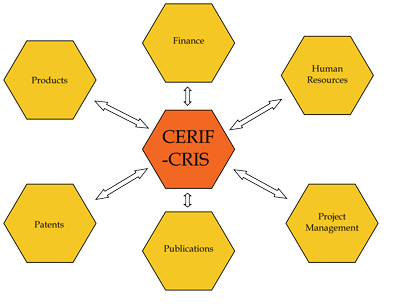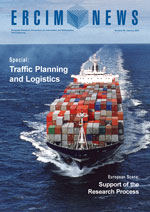by Keith G Jeffery
Information technology has been used to support parts of the research process for many years. Research funding organisations have systems to manage project proposals and grants awarded. Universities have systems to keep track of research projects. Laboratory notebook systems have been developed, some with a workflow component. Portals to access research publications and research datasets and software have been developed. However, these systems tend to be stand-alone, heterogeneous, incompatible with each other and of varying stages of maturity.
The Common European Research Information Format (CERIF) was developed with the support of the European Commission (EC) in two major phases: from 1987-1990 and 1997-1999. It is a standard; technically it is a recommendation by the European Union to its member states. Since 2002, care and custody of CERIF has been handed by the European Commission to euroCRIS, a not-for-profit organisation dedicated to the promotion of CRIS (Current Research Information Systems).

The rationale behind CERIF is as follows. Most nation-states maintain publicly supported research programmes. It is realized that public sponsorship of research and development leads to wealth creation and improvement in the quality of life. Because public funding is involved, it is necessary for there to be appropriate governance, and also for the information to be made available to the public. Broadly, each nation state has a similar research process, which involves strategic planning, programme announcement, a call for proposals, proposal evaluation and awarding, project result monitoring, and project result exploitation.
However, research is international. A research project in country A is likely to be based on previous research in several other countries. Many research projects are now transnational: well-known examples include the human genome and climate change but there are many others, especially where expensive infrastructure is utilized such as particle physics or space science. Furthermore, knowledge of the research activity in country A may influence the research strategy "including priorities and resources provided" of country B.
Thus there is a need to share research information across countries, or even between different funding agencies in the same country. The information is used by researchers (to find partners, to track competitors, to form collaborations); research managers (to assess performance and research outputs and to find reviewers for research proposals); research strategists (to decide on priorities and resourcing compared with other countries); publication editors (to find reviewers and potential authors); intermediaries/brokers (to find research products and ideas that can - with knowledge transfer - be transformed to wealth-creation); the media (to communicate the results of R&D in a socio-economic context) and the general public (for interest).
Within Europe the importance of sharing information has long been recognised. In the early eighties, the heads of some national research funding organisations initiated a project named IDEAS to investigate linking databases of research information. The follow-on project EXIRPTS (1987-1989) extended this - based on the G7 countries - to include USA and Japan. Both projects successfully demonstrated: (a) resolution of schema differences between heterogeneous distributed databases; (b) translation and distribution of queries as subqueries to the different target systems; and (c) integration of the results of the distributed subqueries and presentation back to the queryier. The technology utilized a specially developed protocol, run over email and file transfer. It should be noted that this was well before the emergence of the World Wide Web.
It is from this work that CERIF emerged, first as a simple standard (not unlike a library catalogue card or the present Dublin Core Metadata Standard). It was intended as a data exchange format, and was based on records describing projects, with persons and organisational units as attributes. However, it was soon realized that in practice this CERIF91 standard was inadequate: it was too rigid in format, did not handle repeating groups of information, did not support multiple languages and character sets, and did not represent in a sufficiently rich way the universe of interest.
In response, a new group of experts was convened and CERIF2000 was generated. The latest version (CERIF2006) is described in detail at http://www.eurocris.org/, with its essential features being:
-
it has the concept of objects or entities such as project, person, or organisational unit with attributes
-
it supports n:m relationships between them (and recursively on any of them) using 'linking relations', thus providing rich semantics including roles and time
-
it is fully internationalized in language and character set
-
it is extensible without prejudicing the core datamodel, thus providing guaranteed interoperability at least at the core level while not precluding even richer intercommunication. It is designed both for data exchange (data file transfer) and for heterogeneous distributed query/result environments.
CERIF is now in use in numerous organisations. One commercial company (uniCRIS AG, http://www.unicris.com/) offers CERIF-compatible systems and three others have stated that they will evolve their system offerings to do so. The European Science Foundation has specified CERIF in its new IT system and CORDIS, the EU R&D Web site, is evaluating how best to be CERIF-compatible. Several ERA-NETs funded by the EC use CERIF to allow interoperation of information on research in each member state. The projects IST-World and CISTRANA, both aimed at providing an overview catalogue of European research, use CERIF.
Within euroCRIS, an active task group is developing CERIF and provides advice on how best to use it. To participate, anyone interested is requested to contact EuroCRIS.
Links:
EuroCRIS: http://www.eurocris.org
Keith G Jeffery, Anne Asserson: 'Supporting the Research Process with a CRIS': http://epubs.cclrc.ac.uk/work-details?w=35466Keith G Jeffery, Anne Asserson: 'CRIS Central Relating Information System': http://epubs.cclrc.ac.uk/work-details?w=35484

Please contact:
Keith Jeffery
CCLRC, UK
President of euroCRIS
President of ERCIM
E-mail: kgj![]() rl.ac.uk
rl.ac.uk










